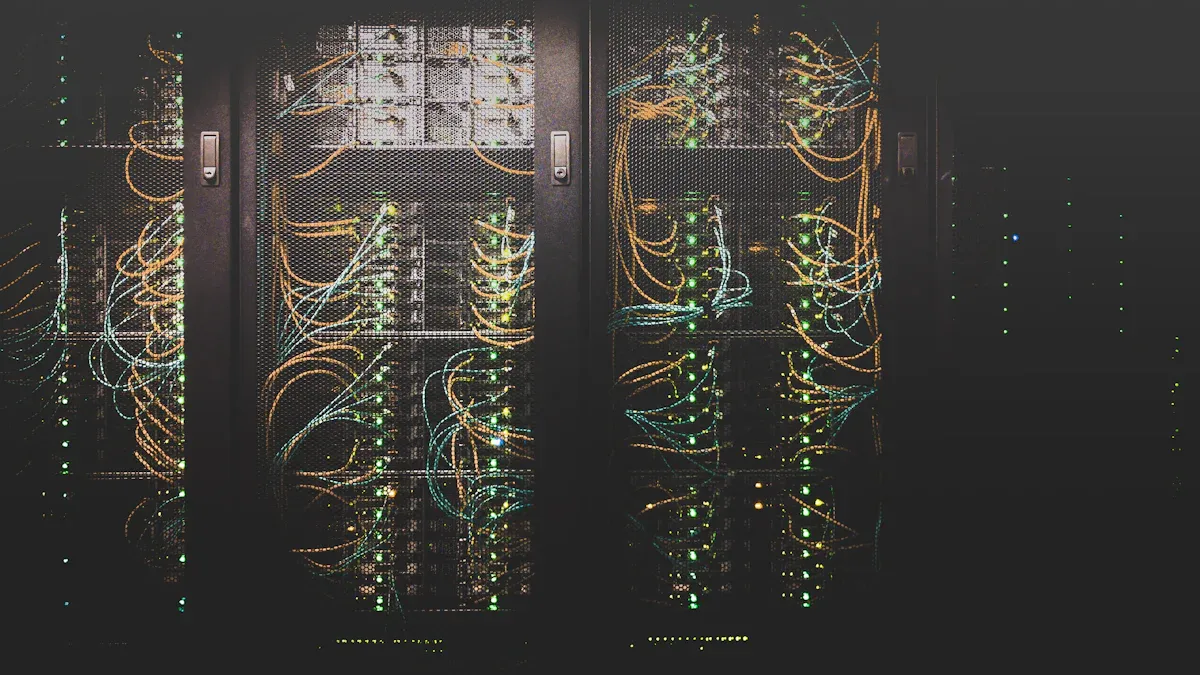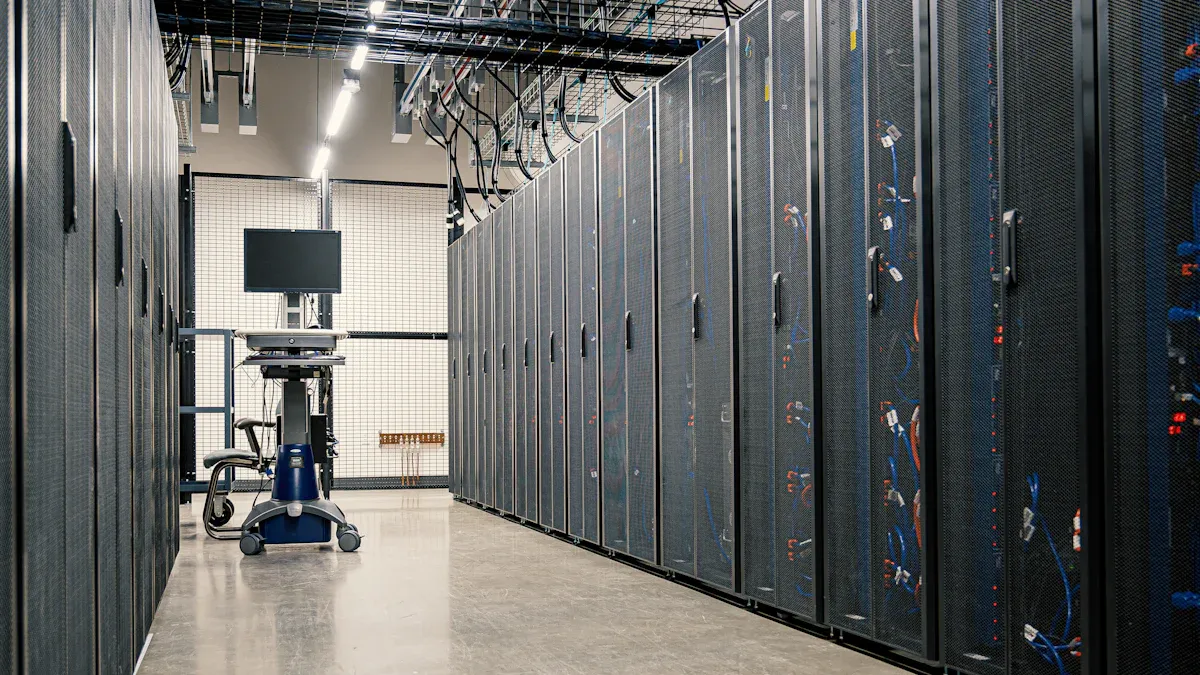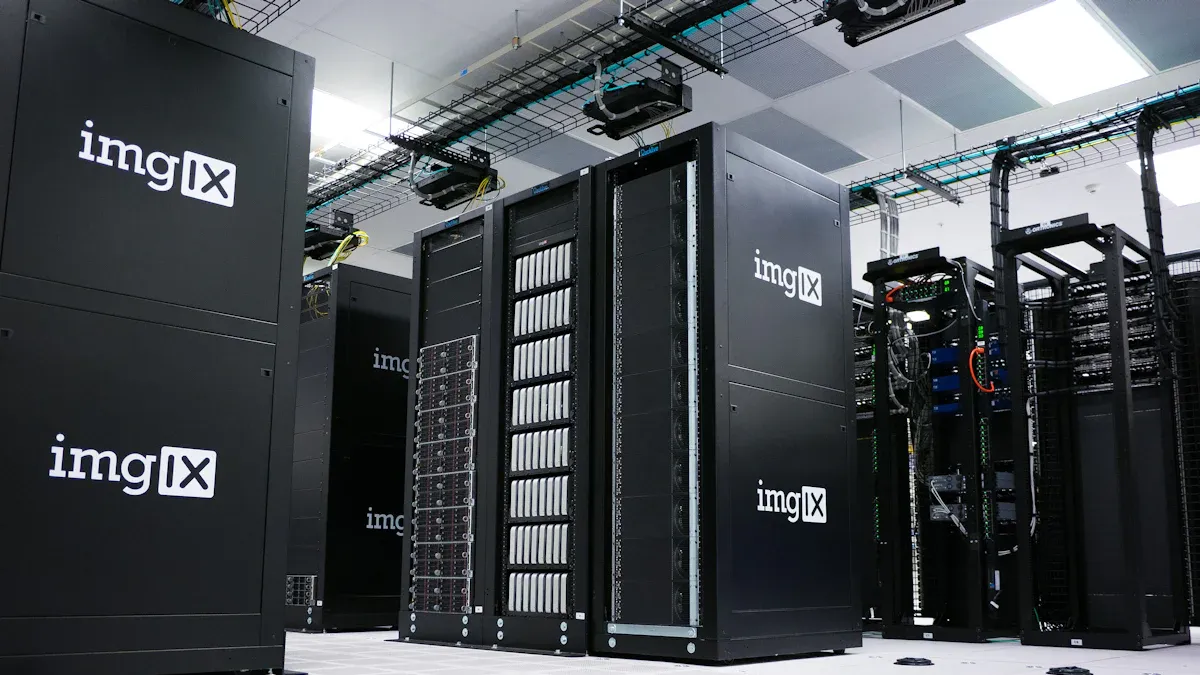
A Power Distribution Unit (PDU) supplies power to many devices from one source. In places with lots of electronics, risks like these often appear:
- Plugging several high-power devices into one outlet
- Outdated wiring
- Poor planning for device capacity
A Pdu Switch helps organize and control power, reducing these dangers.
Key Takeaways
- PDUs safely distribute power from one source to many devices, preventing overloads and protecting equipment with features like circuit breakers and surge protection.
- Different types of PDUs—from basic to intelligent with Pdu Switches—offer varying levels of control, monitoring, and remote management to fit diverse needs and improve uptime.
- Using PDUs helps organize cables, monitor energy use, and support scalable, efficient power management in data centers, server rooms, and industrial settings.
How a PDU Works

Power Distribution Function
A Power Distribution Unit (PDU) manages and delivers electrical power from a single source to multiple devices in a structured and secure way. The PDU converts one or a few power inputs into many outputs, usually through several outlets. This setup allows servers, routers, and switches to receive reliable and balanced power.
PDUs distribute power from sources like uninterruptible power supplies (UPS), generators, or utility lines. Basic PDUs work much like power strips, providing multiple outlets for devices. Advanced models, such as metered or switched PDUs, offer real-time monitoring, remote control, and load balancing. These features help maintain uptime and protect critical infrastructure.
Tip: Modern PDUs often include surge protection and energy monitoring to keep equipment safe and ensure continuous operation.
The power distribution process in a PDU involves several steps:
- The PDU receives power from the main source, such as the grid or a UPS.
- It conditions and regulates the voltage if needed.
- The PDU then distributes the power to multiple outlets, each connected to different devices.
- Advanced PDUs monitor power usage and can alert administrators to potential issues.
- The system balances the load across outlets, preventing overloads and ensuring stable operation.
Key Components of a PDU
PDUs contain several essential components that support their function and reliability. Each part plays a specific role in distributing power and protecting equipment.
| Component | Function |
|---|---|
| Main circuit breaker | Protects the PDU and connected devices by shutting off power during overloads |
| AC inlet and outlet | Connects the PDU to the main power source and provides outlets for devices |
| Relays | Allow switching and monitoring of power across multiple devices |
| EMI filters | Block electromagnetic interference from entering the power line |
| Control board | Enables configuration and displays metering parameters |
| Remote control connections | Allow operators to manage the PDU from a distance |
| GFI module | Provides ground-fault protection to prevent electrical accidents |
| Auxiliary output | Monitors breaker status and connections |
| Main output | Distributes primary power to connected equipment |
PDUs in commercial settings typically operate at voltages such as 208V (three-phase) or 240V (single-phase), with current ratings from 16 Amps to 100 Amps. Matching the PDU’s rating with the circuit rating is important for safety and efficiency.
Safety and Organization Benefits
PDUs provide several safety features that protect both equipment and personnel. Circuit breakers and surge protectors are standard in many units. Circuit breakers shut off power if the current exceeds safe limits, preventing overheating and electrical fires. Surge protectors absorb or redirect excess energy during voltage spikes, such as those caused by lightning, to prevent damage to sensitive electronics.
Note: These safety mechanisms are vital in environments like data centers, where reliable power and equipment protection are essential.
PDUs also offer significant organizational benefits:
- Real-time monitoring and remote management allow quick responses to power issues, reducing downtime.
- Integrated cable management systems help organize cables, reduce clutter, and improve airflow.
- Features like remote power cycling and alerts streamline maintenance and make troubleshooting faster.
- Modular designs and universal outlets support easy upgrades and changes without extensive rewiring.
| Organizational Benefit | Explanation |
|---|---|
| Enhanced Energy Efficiency | Real-time power usage data helps identify energy savings and reduce costs. |
| Improved Reliability and Uptime | Monitors load distribution to detect issues early and increase uptime. |
| Streamlined Management | Offers comprehensive reporting for strategic planning and upgrades. |
| Scalability | Adapts to changing power needs, supporting business growth. |
| Environmental Monitoring | Sensors track temperature and humidity for optimal equipment operation. |
By reducing cable clutter and supporting efficient maintenance, PDUs help keep high-density electronic environments safe, organized, and ready for future growth.
Types of PDUs and PDU Switch Options

Basic PDUs
Basic PDUs serve as the foundation for power distribution in many IT environments. These units act like high-capacity power strips, delivering electricity to multiple devices without advanced monitoring or control features. They do not offer remote access or alerting capabilities, making them ideal for straightforward, cost-effective power distribution.
| Feature | Basic PDUs | Intelligent PDUs |
|---|---|---|
| Primary function | Distribute power to multiple outlets | Distribute power plus monitor and control power usage |
| Monitoring capabilities | None | Real-time power, voltage, and current monitoring |
| Remote access | No | Yes, via web interface or SNMP |
| Control features | None | Remote outlet power cycling |
| Environmental monitoring | None | Temperature and overload alerting |
| Integration with DCIM | No | Yes, supports data center infrastructure management |
| Use case | Cost-efficient, straightforward power needs | Environments requiring uptime, energy efficiency, remote management |
Many organizations choose basic PDUs for small data centers or less critical applications. These units provide reliable power distribution where remote monitoring is not necessary. Lenovo’s 0U Basic PDUs, for example, offer flexible installation, branch circuit protection, and high capacity up to 23 kW. They help minimize downtime and simplify cable management, making them suitable for environments that prioritize simplicity and cost-efficiency.
Tip: Basic PDUs work best in scenarios where only essential power distribution is needed and advanced features are not required.
Metered PDUs
Metered PDUs add a layer of intelligence by measuring and displaying power usage data. These units monitor key electrical parameters such as voltage, current, and energy consumption in real time. They provide live power usage data through integrated displays or remote management tools, allowing precise monitoring and management.
- Metered PDUs measure power consumption at different levels:
- Inlet metering shows total rack power usage.
- Outlet metering provides data for individual devices.
- Circuit breaker metering offers load warnings to prevent overloads.
- Configurable real-time alerts notify administrators when power usage exceeds safe thresholds.
- Integration with data center infrastructure management (DCIM) tools supports centralized monitoring and reporting.
| Feature | Basic PDUs | Metered PDUs |
|---|---|---|
| Cost | Low-cost, entry-level solution | Higher cost due to advanced features |
| Monitoring | No real-time monitoring | Real-time monitoring with built-in meters |
| Control | Limited control, no remote management | Outlet-level control and monitoring available |
| Overload Prevention | No alerts for overloads | Alerts for approaching circuit limits |
| Use Cases | Small to medium data centers, budget-conscious | Larger data centers needing detailed monitoring |
Metered PDUs help IT teams optimize energy distribution, maintain system reliability, and improve operational efficiency. Inlet metering helps avoid circuit overloads, while outlet metering identifies underutilized servers and supports cost allocation. Branch circuit monitoring provides early warnings for high loads, reducing unplanned downtime.
Switched PDUs (PDU Switch)
Switched PDUs introduce advanced control with the Pdu Switch feature. This type of PDU allows remote on/off control and power cycling of individual outlets. IT managers can reboot devices, schedule power sequencing, and manage power distribution efficiently from anywhere.
- Remote switching enables controlled on/off or rebooting of outlets.
- Power sequencing delays minimize inrush currents, protecting connected devices.
- The Pdu Switch prevents unauthorized device provisioning and supports secure access with authentication protocols.
- Real-time alerts notify users of power fluctuations or potential issues.
- Integration with network management systems allows centralized oversight and proactive troubleshooting.
Note: The Pdu Switch feature is critical for reducing downtime in data centers. Administrators can reboot locked-up servers remotely, saving time and operational costs.
Switched PDUs also support dual-input power redundancy, ensuring continuous operation even if one power source fails. Selective power control lets IT teams power down non-essential devices during off-hours, reducing energy costs. These capabilities make the Pdu Switch indispensable for dynamic IT environments that require remote power management.
Intelligent PDUs
Intelligent PDUs represent the most advanced option for power distribution and management. These units combine real-time monitoring, remote management, and environmental sensing to deliver comprehensive control.
- Intelligent PDUs track power consumption, temperature, humidity, and other environmental parameters.
- Remote management allows switching individual outlets and scheduling power cycles for unused equipment.
- Advanced reporting features provide historical data analysis and trend identification.
- Capacity planning tools help optimize power usage and support future expansion.
- Integration with DCIM and building management systems streamlines operations and enhances energy efficiency.
Intelligent PDUs enable data center managers to optimize energy consumption, reduce maintenance downtime, and protect critical infrastructure. Real-time analytics support proactive power management, while environmental sensors help prevent hotspots and overheating. These PDUs can reduce energy consumption by up to 20% and cut power waste by as much as 30%.
Callout: Intelligent PDUs, especially those with a Pdu Switch, allow centralized control and automation, making them essential for modern, energy-efficient data centers.
Rack-Mount and Floor-Mount PDUs
PDUs come in two main installation styles: rack-mount and floor-mount. Each type serves different needs based on capacity and deployment environment.
| Feature | Rack-Mount PDUs | Floor-Mount PDUs |
|---|---|---|
| Installation Location | Inside server racks or cabinets | Standalone units on the data center floor |
| Mounting Style | Horizontal (1U/2U) or vertical (0U) | Floor placement, no rack integration |
| Outlet Count | 8 to 60 outlets | Supports multiple racks with many circuits |
| Power Capacity | Moderate, for individual racks | High capacity, 300kVA or more |
| Use Case | Power within a single rack | Power to multiple racks or cabinets |
| Size | Fits standard rack units | Larger, standalone units |
| Safety Features | Locking outlets, color-coded sections | Compartmentalized designs for safety |
| Installation Hardware | Requires mounting hardware | Requires floor space and high-capacity sources |
| Monitoring | Available in smart PDUs | Often includes advanced monitoring |
- Rack-mount PDUs fit inside server racks or cabinets. They work well in data centers, network closets, and small office IT spaces. These PDUs manage power within high-density racks and support both vertical and horizontal mounting.
- Floor-mount PDUs serve larger data centers. They distribute power to multiple racks or rows and function like circuit breaker panels. These units handle high-capacity power delivery and often include advanced monitoring and power conditioning.
Tip: Choosing between rack-mount and floor-mount PDUs depends on the size of the facility and the required power capacity. The Pdu Switch feature is available in both types, offering flexibility for different environments.
Where and Why PDUs Are Used
Data Centers
Data centers rely on PDUs to deliver stable power to servers, storage, and networking equipment. PDUs help prevent outages and keep systems running smoothly. Operators use advanced PDUs to monitor power in real time, balance loads, and respond quickly to problems. High-quality PDUs undergo strict testing and carry certifications like UL to ensure safety and reliability. Many data centers choose intelligent or switched PDUs for remote management and rapid troubleshooting. These features help reduce downtime and support growth as more devices are added.
- PDUs distribute power to many devices, reducing the risk of outages.
- Real-time monitoring and remote control allow fast response to power issues.
- Load balancing and surge protection protect equipment from damage.
- Certified PDUs meet strict safety standards, supporting reliable operations.
Server Rooms
Server rooms face unique challenges, such as limited space and high power density. PDUs address these issues by providing centralized power management and supporting flexible installation. Intelligent PDUs offer live energy monitoring, which helps save energy and reduce costs. Remote monitoring improves maintenance response times and helps prevent downtime. PDUs also include safety features like circuit breakers and surge protection, which protect valuable equipment.
- Centralized power management reduces human error.
- Energy monitoring helps optimize usage and lower risks.
- Safety features prevent damage from electrical surges.
Industrial and Commercial Settings
Many industries use PDUs to manage power safely and efficiently. Common settings include electronics manufacturing, science labs, telecommunications, and electrical industries. PDUs in these environments often support three-phase power and must meet international safety standards. Features like ground fault detection, circuit breakers, and remote monitoring help operators manage risks and comply with regulations.
- Electronics and science labs
- Telecommunications facilities
- Industrial environments and network closets
- Portable venues such as expos and concerts
Benefits in These Environments
PDUs provide several key benefits across all these settings:
| Benefit | Description |
|---|---|
| Uptime and Reliability | Stable power supply minimizes downtime and protects equipment. |
| Energy Efficiency | Real-time monitoring helps identify and reduce energy waste. |
| Safety and Compliance | Certifications and safety features prevent hazards and support regulations. |
| Scalability | Modular designs support growth and changing power needs. |
PDUs help organizations save energy, reduce costs, and maintain safe, reliable operations in demanding environments.
PDUs play a vital role in powering multiple devices safely. Choosing the right PDU type, such as one with a Pdu Switch, improves equipment safety and performance. Key factors include power capacity, connector type, mounting options, and monitoring features. Advanced PDUs help prevent overloads and support reliable operation.
FAQ
What is the difference between a PDU and a power strip?
A PDU manages power for many devices in critical environments. A power strip provides basic outlets for home or office use.
Tip: PDUs offer advanced features like monitoring and remote control.
Can a PDU prevent equipment overload?
Yes. A PDU monitors power usage and can shut off outlets during overloads. This protects equipment and reduces the risk of electrical fires.
Do PDUs require special installation?
Some PDUs need professional installation, especially in data centers. Basic PDUs often allow simple plug-and-play setup for smaller environments.
Post time: Jul-20-2025





